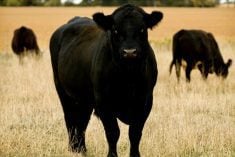Turning cows out onto stubble fields is a good way to utilize forage resources,” says Barry Yaremcio, beef/forage specialist at the Alberta Ag-Info Centre in Stettler. “They will pick and choose what they eat from the straw, chaff, weed seeds in the stubble, slough hay from the low areas and mature hay growing along the fences and headlands.
“The quality of what they eat can be variable depending on the type of crop grown, fertility program and stage of maturity when the crop was cut or harvested. The combine setting — the amount of light grain and weed seeds thrown out onto the ground will impact what the cows eat as well.”
Read Also

Body condition, nutrition and vaccination for brood cows
One of the remarkable events of the past century related to ranching has been the genetic evolution of brood cows….
Straw, chaff, and overmature grass hay typically have low amounts of protein, energy, calcium and magnesium. “These feeds are also high in neutral detergent fibre (which can reduce total feed intake) and relatively high in phosphorus,” says Yaremcio. “Grains and weed seeds are also high in phosphorus and have higher energy and protein content than the grasses, straw and chaff.”
Cow-calf pairs that are turned onto stubble fields have different mineral supplementation requirements compared to when they were on a mixed alfalfa — grass pasture. The lack of calcium and magnesium in the straw and forages can cause two problems.
A diet that is low in calcium and higher in phosphorus can reduce phosphorus absorption. Phosphorus is the driver of all metabolic functions. When phosphorus is not absorbed, feed intake is reduced which in turn reduces milk production and weight gain on the calves. Cows can also start to lose weight. If the imbalance continues, it can impair reproductive performance — with cows taking longer to cycle and conceive a calf next year.
A calcium/magnesium deficiency can cause cows to go down and it generally requires a veterinarian to treat animals in this situation.
A mineral supplementation program should contain additional calcium and magnesium.
“When it comes to calcium, in many cases, a 2:1 mineral does not provide enough calcium to remedy the situation,” notes Yaremcio. “A feedlot mineral with a 3:1 or 4:1 calcium-to-phosphorus ratio is preferred. If a 1:1 or 2:1 mineral is left over from the summer, mix one bag of limestone (38 per cent calcium) with one bag of mineral and one bag of fortified trace mineral salt (with selenium). This mixture (roughly 165 pounds) should be consumed by 100 cow-calf pairs in five to six days. If consumption is too low, add dried molasses to improve consumption. Add eight to 10 pounds of dried molasses to the entire mix and adjust to get the proper intake.”
If feeding a straight mineral, magnesium content should be in the three to five per cent range if the recommended intake is between 70 and 100 grams per day. “The added magnesium along with the calcium reduces the risk of downer cows,” explains Yaremcio. “If magnesium is not present in the mineral, it can be purchased as an individual product from some feed stores or feed mills.”
Feeds that are overmature or crop aftermath are usually low in protein.
“A lactating cow requires 11 per cent protein (minimum on a dry basis) to maintain feed intake and milk production,” says Yaremcio. “Dry cows can manage on eight per cent protein. Supplementing protein on pasture is troublesome. Protein tubs or blocks will help solve the problem, but the mineral and vitamin supplementation should still continue as described above. Feeding three to four pounds of grain every third day along with a protein supplement is another option. Putting weaned cows onto these fields is an option to reduce protein requirements.”
If the energy and protein requirements of the cow are not met, the cow will not be producing much milk, says Yaremcio. “This will reduce calf gains. To offset the loss of calf performance, creep feeding the calves with a ration that is between 14 and 16 per cent protein will improve average daily gains. If feeding straight oats, which has 10 to 11 per cent protein on average, the calves will put down fat rather than lean growth and they could possibly not frame out properly resulting in fat, dumpy butterballs that will be discounted at auction. A mixture of one-third peas and two-thirds oats or barley by weight will provide a creep ration that meets protein and energy requirements. With lower grain prices and high calf prices creep feeding will pay very well in the long run.”
















